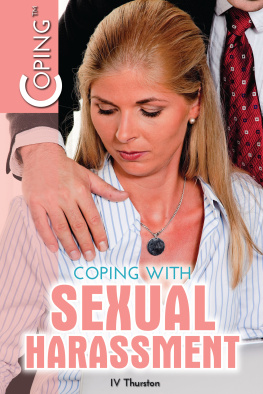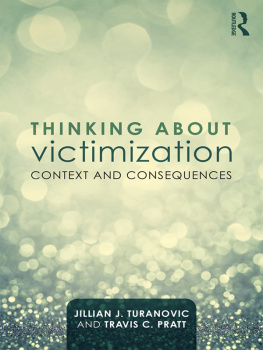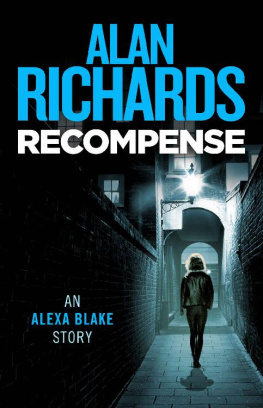I would like to dedicate this book to my nephews: Landon,
Chase, and Wesley. Each of you continually surprise and amaze me.
Tara N. Richards
I would like to dedicate this book to my goddaughters, Lydia and Katie.
I look forward to seeing you grow and mature into beautiful and
strong young womenI love you and am proud of you.
Catherine D. Marcum

Copyright 2015 by SAGE Publications, Inc.
All rights reserved. No part of this book may be reproduced or utilized in any form or by any means, electronic or mechanical, including photocopying, recording, or by any information storage and retrieval system, without permission in writing from the publisher.
Printed in the United States of America
Library of Congress Cataloging-in-Publication Data
Sexual victimization : then and now / [edited by]
Tara N. Richards, University of Baltimore, Catherine D. Marcum, Appalachian State University.
pages cm
Includes bibliographical references and index.
ISBN 978-1-4833-0817-3 (pbk.)
Sex crimesUnited States. 2. Sexual abuse victimsUnited States. 3. Criminal justice, Administration ofUnited States. I. Richards, Tara N. II. Marcum, Catherine Davis
HV6592.S4864 2015
362.8830973dc23 2013036560
This book is printed on acid-free paper.
14 15 16 17 18 10 9 8 7 6 5 4 3 2 1
FOR INFORMATION:
SAGE Publications, Inc.
2455 Teller Road
Thousand Oaks, California 91320
E-mail:
SAGE Publications Ltd.
1 Olivers Yard
55 City Road
London EC1Y 1SP
United Kingdom
SAGE Publications India Pvt. Ltd.
B 1/I 1 Mohan Cooperative Industrial Area
Mathura Road, New Delhi 110 044
India
SAGE Publications Asia-Pacific Pte. Ltd.
3 Church Street
#10-04 Samsung Hub
Singapore 049483
Acquisitions Editor: Jerry Westby
Editorial Assistant: MaryAnn Vail
Production Editor: Melanie Birdsall
Copy Editor: Paula L. Fleming
Typesetter: C&M Digitals (P) Ltd.
Proofreader: Jeff Bryant
Indexer: Sue Nedrow
Cover Designer: Anupama Krishnan
Marketing Manager: Terra Schultz
Detailed Contents
Amanda Burgess-Proctor and Christopher G. Urban
Lane Kirkland Gillespie and Laura King
Shelly Clevenger
Tammatha L. Clodfelter
Tara N. Richards and Lauren Restivo
Leah E. Daigle, Sadie Mummert, Bonnie S. Fisher, and Heidi L. Scherer
Sarah Koon-Magnin
Kelsey Becker and Catherine D. Marcum
Tammy Garland and Christina Policastro
Xavier Guadalupe-Diaz
Jamie A. Snyder and Heidi L. Scherer
Joan A. Reid
Preface
A fter almost three decades of activism and legal reform, the criminal justice system, with the help of noncriminal justice system partners, has made great strides regarding the handling of cases of sexual victimization, including how sexual victimization is defined, how evidence is collected, and how cases are prosecuted as well as how victims are treated by criminal justice system actors. Every state now includes rape and sexual assault in its penal code, and many states definitions of forcible rape include language pertaining to diverse groups of victims, including special populations of victims such as prisoners and the elderly. In addition, many police departments now assist in the facilitation of victims court advocates and counseling services postsexual assault. However, there are still ways in which criminal justice practitioners, activists, and scholars could advance their understandings of sexual victimization and improve the treatment of victims as they move through the criminal justice process. This continuum of change, as well as the lack thereof, was inspiration for the development of this book. We as the editors felt as if the academic community, as well as practitioners, could benefit from a text that outlined the various facets of then and now in regard to sexual victimization as a whole.
The purpose of this project is to produce a book that provides scholars easy access to information that specifically examines the continuum of change in the sexual victimization field. It is the desire of the editors to educate and enlighten a wide audience, from those who are completely unfamiliar with the topic to individuals who need more specific information on a particular type of sexual victimization. This text should be a useful guide to students, academics, and practitioners alike.
Acknowledgments
W e would like to extend a huge thank you to all the contributors of this book. Your expertise in the field will provide enlightenment and insight to academics and students alike. All your hard work is appreciated.
Thank you to Jerry Westby, MaryAnn Vail, and the staff at SAGE for their assistance and patience with the preparation of this manuscript. It was wonderful to work with a group of individuals who shared the same vision for this book. We hope it is a great success.
Finally, thank you very much to the following reviewers of this text for their thoughts and insight on improving the book:
Kelley Christopher, University of West Georgia
Wendy Perkins Gilbert, Urbana University
Sheri Jenkins Keenan, Cameron University
Rebecca Loftus, Arizona State University
Stephanie P. Manzi, Roger Williams University
Christine L. McClure, Cape Cod Community College
Elizabeth Quinn, Fayetteville State University
Bradford W. Reyns, Weber State University
We hope you are pleased with the finished product.
State Variations on Definition of Sexual Assault
Amanda Burgess-Proctor and Christopher G. Urban
T he task of evaluating state sexual assault statutes is more complicated than it might appear at first. States have long ago abandoned a solitary rape law in favor of more nuanced and multilayered sets of laws. Even a cursory exploration of sexual assault legislation demonstrates that these laws address a wide variety of proscribed behaviors, including (but not limited to) child sexual assault; adult sexual assault; statutory rape; rape occurring within correctional, educational, and other specific populations; sodomy; and bestiality. There is also tremendous variation in the terminology states use to describe sexual assault (sexual abuse, criminal sexual conduct, sexual battery, sexual torture, etc.), and there likewise exists no necessary consistency in the definitions of these terms across states. Even the language states use to define consent varies considerably, as does the standard by which consent (or lack thereof) is measured.
Thus, a tidy summary of state legislative definitions of rape and sexual assault remains elusive, particularly within the context of this brief essay. In addition, we elected to focus solely on adult offenses, as child sexual assault brings with it a category of offenses (child pornography, pedophilia, incest, and so on) that would broaden our analysis beyond the intended scope of this essay. As a result, we do not address statutory rape or the development of age-of-consent laws, though analyses of these laws are readily available elsewhere (see Davis & Twombly, 2000; NIC, 2006; Oberman, 1994).












